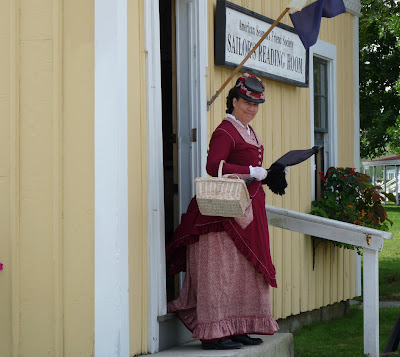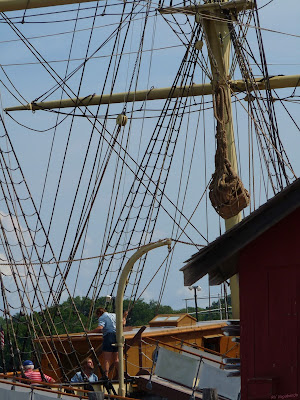Mystic Seaport--say it and my mind conjures a vision of sailors, whalers and misty waters. I've always been intrigued by the sound of the name and on Thursday Denny and I finally found our way to The Museum of America and the Sea; Mystic Seaport in Connecticut.
The two of us were pleased upon arriving in town to find clearly marked signage for parking to the museum and a short walk to the entrance of the complex. Because Mystic Seaport is indeed a huge complex and you will be doing a lot of walking later. Upon entering the ticket area you are informed that your ticket is good for two days and that there will be people wearing name tags through the grounds that are available to answer any and all questions you might have. I used a 10% off coupon I got online at the Mystic Seaport web site to purchase our tickets. There are a variety of discounts available along with a special pass that gives you additional benefits.
After you exit the ticket building the first thing you notice on your left is the huge whaling ship undergoing restoration. The
Charles W. Morgan is the last wooden whaling ship in existence and it has been declared a National Historic Monument. The neat thing is that you can actually go inside the ship and wander around while the restoration is under way. Denny and I spoke to a volunteer who was scraping down the galley area, a small space of about four feet by six feet that was the kitchen area used to feed thirty-five people. I commented that the kitchen in my RV was larger and the woman laughed and said it was about the size of her kitchen in New York City. Now
that I can believe!


The height of the hold of this whaling ship is only about five feet--obviously people were smaller or the sailors became awfully stooped over time!

Next we wandered over to the Baltimore Clipper, the
Amistad. The photo below is not canted at an angle; the two masts are actually tilted backwards which allowed the clipper to sail much faster than other ships of the day. Baltimore Clippers were used by Americans in the War of 1812 to capture British ships and after the war they were favored by pirates and those running goods from China due to their speed at sea.

Walking the streets of Mystic Seaport is taking a step back in time. The buildings are historically correct and house blacksmiths, print shops, coopers, schools, apothecaries, churches, sail makers, stables and other businesses you'd see in the 19th century. You can wander in and out of these buildings at will and there will be someone there to answer your questions or explain what the building was used for.


There are a lot of "hands on" activities, especially for children. As you are given your ticket and wrist band at the ticket center, you are also given a map which has the daily activities for the museum listed. You can make a lanyard, build a boat, try your hand as a blacksmith.

You will find a "witness to history" here; someone playing the role of a person who lived in the mid 1800s and who stays in character as you speak to him/her.

I did find a lighthouse for my collection, albeit a reproduction of the actual Brandt Point lighthouse.

The Mystic River. This area developed into a major shipbuilding area due to the availability of wood, sheltered waterways and flat land. There were two large shipbuilders here where the museum complex is now located and after shipbuilding started to wane other manufacturing businesses developed in their place, keeping the area viable.

As Denny and I were wandering away from the lighthouse we heard the sound of singing and came upon the
Joseph Conrad, which was full of people listening to one of the employees talk about life aboard a sailing ship.

Intrigued by the singing and a bit awed at the biceps of the young women heaving a heavy load up the rigging, Denny and I stopped Denise to ask a couple of questions about the songs being sung. Denise explained that the
sea shanties were songs sung by the shanty man to develop a rhythm in raising and lowering the sails and hauling loads from the holds, etc. Each shanty man had a huge number of songs in his head and after asking us where we were from, Denise then sang a bit of a shanty that had the Ohio and Mississippi Rivers in its lyrics. To say that Denny and I were impressed is a bit of an understatement! Sea shanties--a fascinating bit of seagoing history and Denise had a lovely voice for singing them.

A cooper (barrel maker) plying his trade. While the clothing may not be historically accurate, the work done here is; even the ship restorers and boat builders here use the old time tools for their work.

In addition to the historical buildings and activities there are special exhibits during the year. Currently there is an exhibit about sailors' tattoos and the tattoo artists and how the craft started. One of the most fun things at this exhibit was a special light that slowly "tattooed" an anchor on your arm as you watched. Computer generated with a buzzing sound in the background you watched as the anchor was inked onto this young lady's arm. Fun stuff!

Of course there are shops to buy things and restaurants on the grounds if you are hungry and park benches where you can sit and watch the river flow by. Most of the buildings are not air conditioned so it was nice to be able to sit for a while in the shade enjoying a bit of a breeze while we people watched.
If you enjoy history and come from a relatively landlocked area like we do, visiting Mystic Seaport is a most enjoyable way to spend a day. Or two.





















































